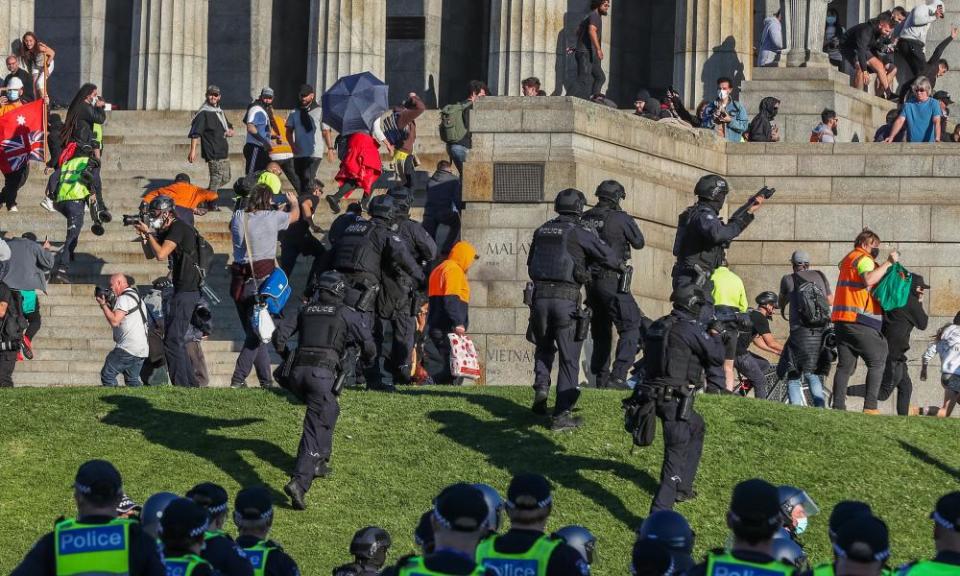Arrest footage and teargas raise concerns about Victoria police’s use of force to quell protests

The use of weapons like teargas and stinger grenades and vision of a man being thrown to the ground by a Victorian police officer at Flinders Street Station has raised concerns about police’s use of force during the ongoing protests in Melbourne this week.
On the fourth day of protests in the city, footage emerged online showing an officer approaching a man from behind and throwing him to the ground. The man appeared to be talking calmly to other officers at the time.
A Victoria police spokesperson said the police were aware of the footage and the professional standards command were investigating the incident.
Related: Riot police end standoff at Melbourne’s Shrine of Remembrance on third day of protests
The civil rights group Liberty Victoria was concerned about the footage.
“It’s deeply concerning. Incidents like that can motivate others in a deleterious way,” spokesperson Michael Stanton said.
“We don’t say police have an easy job – far from it. We’ve seen some shocking scenes of protesters hurling abuse or worse, we’ve seen police getting injured and hospitalised and that’s terrible, but what you don’t want in that situation is to have a disproportionate use of force that could itself spark further unrest.”
Melbourne Activist Legal Support has been monitoring the protests, and spokesperson Anthony Kelly said it was a takedown technique that had been used before, and was potentially excessive.
“It’s good that the police are investigating it and a positive sign, but what we always say with this is that these sort of incidents require [an] independent investigative model to really get to the bottom of it, because they keep happening.”
The protests that have seized Australia’s second-largest city for days had their genesis with members of the powerful Construction, Forestry, Maritime, Mining and Energy Union (CFMEU), who were resisting a government mandate for compulsory coronavirus vaccinations for workers on building sites.

But the initial rally has been seized upon by anti-vaccination and anti-lockdown groups, some including members of the far right, who have organised the rallies over social media sites including Facebook and Telegram.
In the two days since the initial protests, the police presence in the city has expanded significantly, with riot police and large police vehicles out in force across the CBD. There have been more than 200 arrests, and on Wednesday after a three-hour stand-off with protesters at the Shrine of Remembrance, police used non-lethal rounds and teargas to disperse the crowd.
Police said a further 92 people were arrested on Thursday, and the police plan to provide a “highly visible presence” across the city over the next few days.
Kelly said the police’s staged response at the war memorial, where police gave several warnings and allowed protesters to leave, had been noted but the use of non-lethal rounds and teargas could cause serious and permanent injury, and risked being an excessive use of force.
Stanton said Liberty Victoria was deeply concerned about whether the response from Victoria police had been proportionate, and whether the use of such tactics for the current protests would be normalised in future protests outside of the Covid-19 pandemic.
“Certainly, the police were confronted with some worrying conduct in these recent protests, but we’re very concerned that a militarisation of the police response could become normalised for future peaceful protests.”
Related: Melbourne protests: far-right extremists or construction workers?
Kelly said the normalisation process was complex, and if the public supported some of the measures being used then that will factor into whether police feel they can use such measures.
“We’re expecting and hoping the police will roll back all of this crowd control technology very quickly and also not deploy it at all when it’s not needed,” he said.
“It should only be deployed when it’s absolutely necessary.”

The Herald Sun also reported police would be scouring CCTV footage from the city to find and prosecute those who attended the protests. The report suggested police would be attempting to identify people manually, however Victoria police has previously trialled facial recognition technology.
A Victoria police spokesperson refused to say how the force was identifying protesters, stating it would reveal methodology.
The Victorian premier Daniel Andrews on Thursday thanked the police for their “outstanding work” on Wednesday.
“Police were very effective yesterday and I thank them for putting themselves in harm’s way to keep the rest of us safe,” he said.
“I would hope that today and in days to come there is not a need for that, that people are following the rules, doing the right thing, so we can get construction open.”
Ahead of the earlier protests on Saturday, the Human Rights Law Centre called on the Victorian government and the police to be transparent around the justification of the police response, including showing how much Covid-19 transmission has occurred at previous protests.

 Yahoo News
Yahoo News 